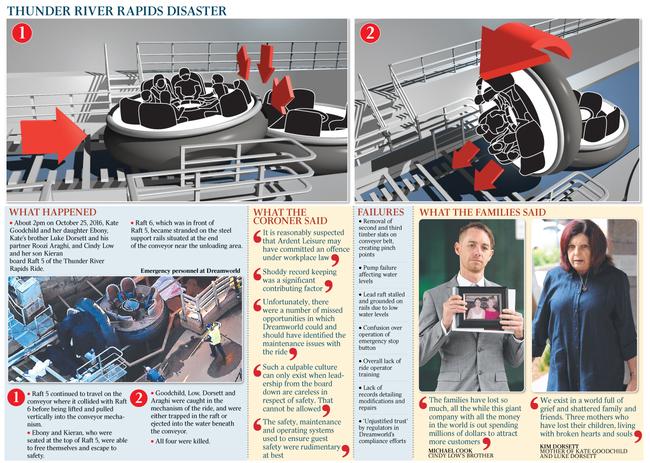Dreamworld thrill ride’s slow descent into a death trap
Every second and third timber slat on the Thunder River Rapids ride’s conveyor had been removed, which contributed to the tragedy.

On Tuesday, October 25, 2016, Dreamworld opened as usual at 10am. The Thunder River Rapids ride began operating with nine rafts in circulation, the maximum allowed with two operators.
The ride was nearly 30 years old and was the most popular in the theme park. It was designed to simulate white water rafting, with six people to a raft. Dubbed a “moderate thrill ride”, it was deemed suitable for people over the age of two.
Many of the major components of the Thunder River Rapids ride were original. But it was subject to fatigue and had had several modifications over the course of its life.
Coroner James McDougall found there was limited information as to why some of these modifications were carried out, when they were done, or whether there was any form of risk assessment either before or after they were made.
According to the coroner: “Documentation provided by Ardent Leisure relating to the history of the ride, including the modifications made and any associated issues, which arose on the ride, are scant at best.”
For example, by October 25, 2016, every second and third timber slat on the ride’s conveyor had been removed. The reason was apparently to reduce weight on the mechanical conveyor which kept the rafts moving.
According to evidence put by the Office of Industrial Relations investigator David Flatman, this was a major contributor to the incident, which claimed four lives. That, combined with inadequate safety training for ride operators and the fact that one raft became stuck on the conveyor, made for a deadly combination of factors, as the inquest would eventually discover.
At about 2pm that day, Cindy Low and her son Kieran, Kate Goodchild and her daughter Ebony Turner, along with Kate’s brother, Luke Dorsett, and his partner Roozbeh Araghi, boarded raft five. The weather was dry and clear.

Raft five travelled through the water course without incident before being picked up by the conveyor at the end of the ride and moved towards an unloading area.
However, the raft in front of raft five had become stranded on the steel support rails situated at the end of the conveyor near the unloading area.
Raft five continued to travel on the conveyor until it collided with the other raft before being lifted and pulled vertically into the conveyor mechanism.
Ebony and Kieran, who were seated at the top of raft five, were able to free themselves and escape.
Goodchild, Low, Dorsett and Araghi were caught in the mechanism of the ride, and were either trapped in the raft or ejected into the water beneath the conveyor.
The ride operators and some patrons tried to help those trapped in the raft and in the watercourse.
Emergency services were contacted, and various Dreamworld staff responded. However, Goodchild, Dorsett, Low and Araghi were declared dead at the scene.
Mr McDougall found that despite the Office of Industrial Relations’ insistence that its officers did on-site auditing of theme park rides and that they were very proactive with the industry generally concerning safety, none picked up the “dangerous state” of the Thunder River Rapids ride as described by independent engineers and inspectors after the tragedy.
He also pointed to the “unjustified trust” held by the government regulators as to the effectiveness of the safety and maintenance systems in place to ensure the ride’s safe operation.
“Clearly, given the nature of this tragedy, and the surrounding circumstances, including the lack of record management, the absence of any meaningful hazard assessments or effective engineering oversight of these devices, this was simply not the case,” he said.
Since the events of October 2016, the coroner said, regulators have stepped up their commitment to thorough auditing, but this simply demonstrated “the absence of adequate prior compliance activity”. This in-depth auditing will need to continue, he said, because self-regulation is “fraught with danger”.


